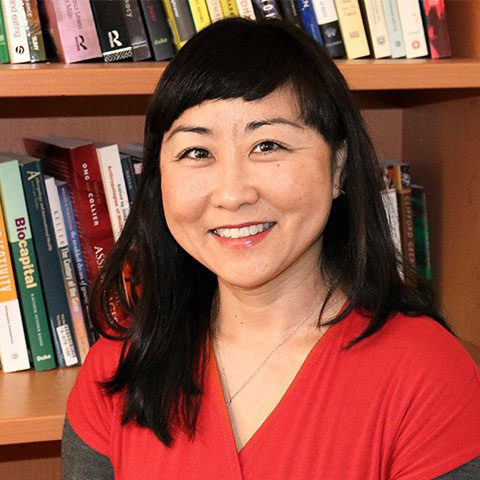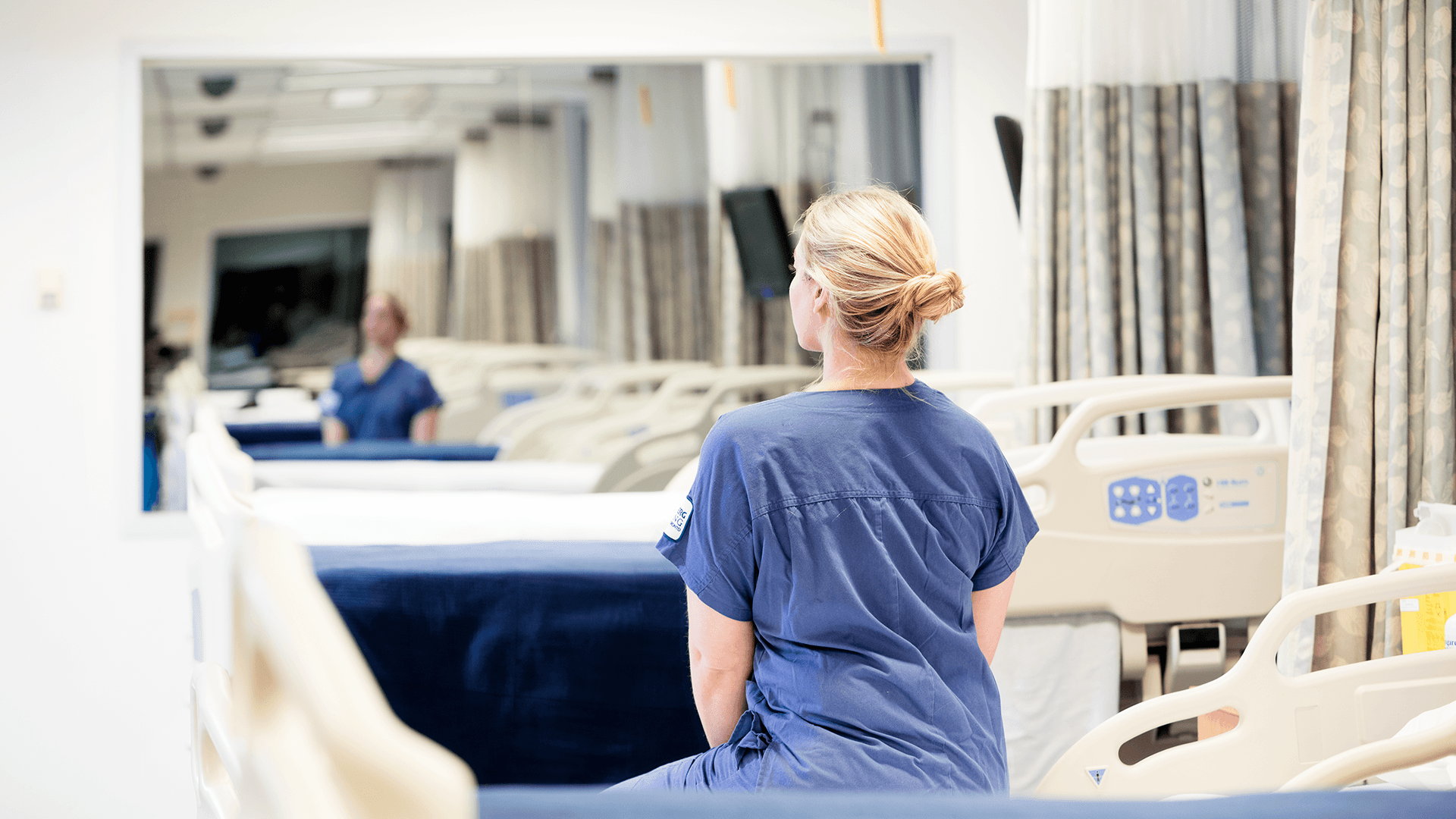In 2015, at the age of 29, Emma Taylor (a pseudonym) entered U of T’s bachelor of science in nursing program. It is an intensive two-year degree: two to three days a week, students are in a hospital for up to 12-hour shifts, and two days a week, they’re in classes – many of which are high level, theoretical courses. Taylor had received an entrance scholarship, and was at the top of her class. She was in love with the program. She also held a job and was dealing with personal difficulties. One night, the sheer enormity of it all caught up with her. What follows is her account of her “rock bottom” accident, her journey to completing her nursing degree (with help from those around her) and her present-day challenges. One of Emma’s nursing professors, Maki Iwase, offers her perspective on Emma’s story in the footnotes.
On March 7, I had a typically busy day. I went to classes, then to a health mentorship session, then to my part-time job at a hospital. I was using every bit of my emotional reserve to get through this program, which would be done in June. I could see the light. But at the same time, I was dealing with issues in my personal life: I’d had a bad breakup. A friend had just died of cancer. I was really being confronted with the darker, sadder side of life. After my hospital shift ended at 9 p.m., I went to a café to catch up on my studies. I was extremely exhausted. I have no memory of getting in my car to go home.
I only remember waking up in the intensive care unit.
I had been in a car crash at a very high speed: I had hit a tree at 120 kilometres an hour. By the grace of God, no one else was in the accident. It was just me who got hurt. If I had hit a pedestrian, he or she would have been dead.
I had a traumatic brain injury; I had hit my head pretty hard. I broke my sternum, which is a very painful experience. I broke many ribs and bruised my heart. There were pulmonary embolisms in my lungs. I was in rough shape.
I woke up on every pain medication, every sedative, under the sun. I was in a neck brace. I reached for my iPhone. I texted my professor. “I don’t think I’ll make it. I might miss class.” I did not understand what had happened to me.1 It was a miracle I came through the accident.
After two days, I was transferred to the trauma unit for three days. Then they set me free. You hear about this all the time. They move to push people out of the acute care setting as soon as they can. They were like, “See you in three months for a follow-up.”
Nurses and clinicians do what they can in a health-care system with finite resources, but the reality was that the care was not awesome. I left with all the wrong prescriptions. I left in an enormous amount of pain. They did a CAT scan, but even though I’d suffered a concussion, they didn’t do an MRI. Both of my parents came down and lived with me.2 We got really close, after everything. I’m so grateful for them. I love them so much.
I was not confined to bed, but I was in the house because I was exhausted. I had about two to three hours of energy to do anything. The pain was keeping me up at night. I couldn’t walk because my ankle was injured. I was having a lot of psychological and emotional reactions to what had happened. I would cry at the drop of a hat. It’s not uncommon to have a mood disorder as a result of a concussion. I thought of how vital I had been before this accident. I’d never had to worry about not being able to think, or sleep, or put on a shirt, or go dancing.
At the time of the accident, I was in a home-care course with Professor Maki Iwase. In this weird cosmic way, I was now living some of the drawbacks of what Maki talked about: About how some really ill people get put back into their homes, and their homes become a hospital, essentially, and their loved ones are responsible for their care. I don’t know what the heck you would do if you didn’t have a mom who was a doctor like I do or if you didn’t have a home to go to.3

I gained a depth and dimension to what I’d been learning at U of T, and this lived experience of being the patient changed how I nurse. I now really understand the gravity of injury and illness. I now deeply understand a patient’s confusion and fear. I now understand what it means to be vulnerable – when you need to go to the washroom and you call the nurse, and you’re made to wait. I think what makes me a better nurse is just that overall understanding – and people can feel if a nurse has that understanding. I could tell the moment the nurse walked in the room if I was going to have a good night or not because I was like, “Does this nurse give a shit or not?” You can tell.
We talked a great deal about advocacy in nursing in my classes, but I didn’t appreciate how important it really is. For instance, I needed a nurse who would’ve said, “I don’t think she should go home yet. Does she have a cardiology follow-up? Does she have an orthopedic follow-up? Does she have any of these setups?” That wasn’t there at all.
When it comes to continuity of care from an acute setting to a home setting, a nurse might say, “Follow up with your family doctor.” I will say, “When you follow up with your family doctor, ask her specifically about this, this and this.” A family doctor doesn’t know exactly what happened in the hospital, and the reality is she might not truly appreciate and follow through with all aspects of a complex trauma case. Really, it’s the patient who carries that continuity of care. I will advocate for patients, and educate them so they receive a proper follow-up in the community.4
When I was ready to return to U of T in April, the level of support I received was shocking to me. The nursing faculty is so special. My program director, Maureen Barry, reached out to me. She asked, “What do you want? How can I help you?” I said, “I want to graduate. I don’t want to lose this year.” There was no, “Oh, well, I think you better just accept you’ve lost your year. I’m so sorry.” Instead, she gave me a step-by-step program of what I needed to do.
Also, one of the lights in my nursing career has been Maki. She said, “I’m going to get you through this home-care course. What I need you to do for me is write the final paper.” This was a very positive, challenging task and I love writing essays. Maki sat with me while I hashed out my plan for the paper. This helped, because it was still really hard for me to synthesize abstract, high-level ideas. Maki let me do it on a time frame that allowed me to do it right and in a way that didn’t exhaust me. I had a gradual re-entry back into everything.5
At the same time, students from the program reached out on Facebook, they phoned, they sent emails, they showed up at the hospital and at my home. Their encouragement was so genuine and touching. I printed out all their messages. When I have bad days, I go back and read them. I still draw so much strength from them.
Really, my job was to accept everyone’s help – and that was hard for me to do, because I’m so independent. A huge way that I grew was to learn to accept the help and to let people see that I need help.
***
The most powerful thing Maki did for me is invite me to talk to my entire class about my experience. I felt ashamed of the car crash. I wasn’t resilient yet. I hadn’t graduated yet. I was still down. She put all the other students around me and she just said, “Tell us what you want to tell us.” Everyone listened intently and they were so respectful.
I got to talk about how I lived the experience that Maki meant to acquaint us with this entire semester and I said, “I can’t tell you enough how right the professors are in terms of what they’re trying to get us to appreciate as clinicians about how confusing it is to be sick in your home. About how much responsibility is on patients who are ill-equipped to navigate their own illness or injury, and how much you can take your body for granted and how much pain can come unexpectedly.”
I remember how proud Maki was of me and how she was crying and how this validated what I was feeling. It was very emotional and powerful and I felt she was, in her way, holding my hand and bringing me back to the circle.
***
I graduated on November 7th, with honours. I felt incredibly proud and grateful. I walked the stage with my classmates who had helped me recover. My parents were in the audience. Maki and Maureen were on the dais, and I could see a little sparkle in their eyes when I walked. I now have a job in the field of acute-care mental health.6
I still have pain; it’s always there in my chest. My ankle hurts, and I wear a brace to work every day. But overall, I am left with a huge sense of gratitude for where I am. The accident was my rock bottom; I was so stressed out and something had to give. I needed more support, and maybe the accident was the way that I needed to learn to ask for support.
But I also have to remind myself that it is OK to be where I’m at. Things can get trivialized very easily by those around us – whether it be a breakup or accident or failing a course. And we’re taught not to look at the bad stuff; get over it and rise above. That starts to become a pressure of its own. People validating my struggles is really important. You don’t get to bounce back strong without first going through horrible challenges. I’m still healing, for sure. I want other people who are facing challenges to feel OK that it takes a long time to heal – both inside and outside.
When I was recovering, I initially tried to get back to the spot of where, and how, I was before. That place is gone. But I’m arriving at a new place.7
Did you experience adversity or a crisis while attending U of T? Did a professor, staff member or fellow students help you through it? Tell us your story at uoft.magazine@utoronto.ca or in the comment box below.
Learning About Home Care While Living It

On the last day of class, I like to do a potluck party. At it, students recap their clinical observations: What was significant for them? What memory can they carry forward in their nursing career that will inform the care that they provide?
I thought Emma had so much to share with her peers, who were witness to her struggles. So I asked her to give a speech. It took courage: It’s living the trauma all over again and required her to show her vulnerability. There were moments when Emma had to stop talking because it was too emotional for her, and because she couldn’t sit in the chair for too long because she had so much pain in her ribs. She was on high doses of pain medication but she still came and she shared her story. It was very moving.
Not only did she share her own lived experience of that transition from acute care to home care, but she told her narrative from a nursing student’s perspective. It also gave her peers a chance to ask difficult questions such as, “What’s it like for you now? What was the most challenging thing for you? What surprised you?” They gave her very affirming support: recognizing her strength, capacity and determination. The students who go through this two-year program develop a bond. They’re incredibly supportive of one another – while they’re learning to take care of patients, they’re learning to take care of themselves and each other, too.
Students can intellectualize the content of the home-care course, but Emma brought it to life, made it very close and real. Her experience underscores how all our lives’ trajectories can change without a moment’s notice and how none of us are immune to falling ill or being in an accident. When it does happen, everyone is vulnerable. We take our health for granted. The reality of accidents or a threat to health is that it is not something that happens and then it’s gone. Emma’s story extended students’ understanding of their own clinical work and spoke to that essential concern, “What do we want when we’re vulnerable and ill? What matters?”


